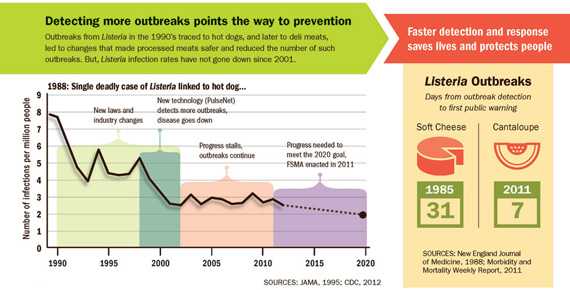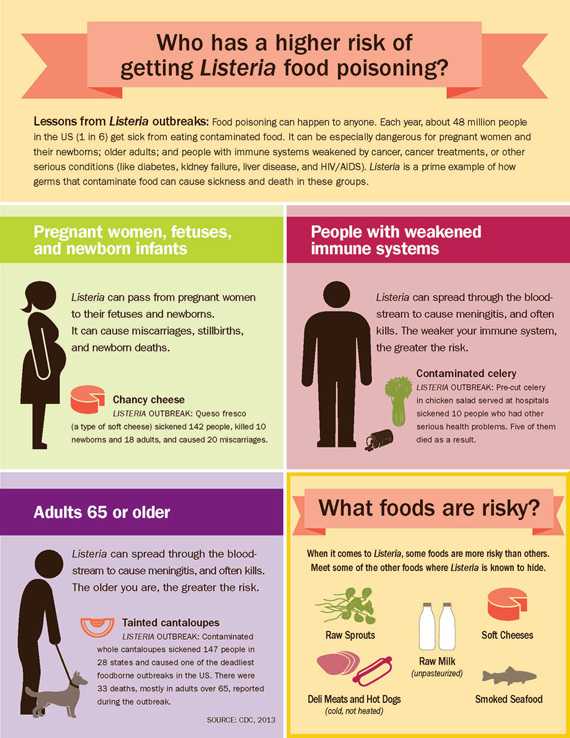Recipe for Food Safety
Protecting people from deadly Listeria food poisoning
June 2013


 1600
1600
About 1,600 people in the US get sick from Listeria germs each year.
 3rd
3rd
Listeria is the 3rd leading cause of death from food poisoning.
 90%
90%
At least 90% of people who get Listeria infections are either pregnant women and their newborns, people 65 or older, or people with weakened immune systems.
Many germs can be spread through food. Some, like Listeria, can be deadly. Listeria strikes hard at pregnant women and their newborns, older adults, and people with weakened immune systems. Listeria can cause miscarriage and meningitis. Most people found to have Listeria infection require hospital care and about 1 in 5 people with the infection die. Outbreak investigations tell us what foods make people sick and what needs to change to make food safer and save lives. We have made some progress against Listeria, which is the third leading cause of death from food poisoning. However, we can do more to protect people at higher risk for food poisoning and make food safer for everyone.
If you, or someone you make food for, are pregnant, 65 or older, or have a weakened immune system, you must be especially careful when selecting, preparing, and storing foods.
- Know your risk of food poisoning.
- Select, prepare, and store food safely.
- Follow the safe food guidelines – Clean, Separate, Cook, Chill – at www.FoodSafety.gov
Problem
Listeria is a deadly germ that is hard to control
Listeria is challenging because
- When someone eats food contaminated with Listeria, sickness or miscarriage may not occur until weeks later when it is difficult to identify which food was the source.
- Listeria can contaminate many foods that we don't usually cook, like deli meats, cheeses and sprouts.
- Some foods we might not suspect can be contaminated with Listeria and cause sickness and outbreaks, such as cantaloupe and celery.
- Listeria is a hardy germ that can even grow on foods that are refrigerated.
- Listeria can hide unnoticed in the equipment or appliances where food is prepared, including in factories and grocery stores.
We can prevent Listeria infections by
- Identifying outbreaks fast by using special laboratory tests and disease detectives.
- Rapidly finding and removing contaminated food before people eat it.
- Using lessons from outbreaks, including environmental investigations, to make food safer.
- Applying new safety measures for food production, like those included in the Food Safety Modernization Act (FSMA), so that food doesn't get contaminated in the first place.
- Reducing Listeria contamination of ready-to-eat meat and poultry products by following USDA guidance [PDF – 2.34 MB].
- Having a robust public health system that provides the tools and resources needed to promote food safety.
- Learning more about which polices and practices work best.
Infographic
What Can Be Done
Federal, state, and local governments are
- Providing guidance to industry and developing regulations, like FSMA, to focus food safety efforts on safer production and handling of foods.
- Tracking Listeria infections to identify opportunities to improve policies and practices, particularly to protect groups at higher risk.
- Investigating and stopping outbreaks by recalling contaminated foods and warning the public.
- Applying CDC's enhanced approach to investigating Listeria infections in all states so disease detectives can rapidly solve outbreaks by:
- DNA fingerprinting the Listeria germ to identify outbreaks and contaminated foods, and interviewing people who are sick—quickly and uniformly—about what they ate. See Listeria Initiative [PDF – 617 KB]
- Building public health capacity for advanced genome sequencing and analysis, which will make it possible to more quickly detect Listeria infections and outbreaks, and track them to their sources.
Food industry and places that sell or serve food can
- Promptly communicate recalls of foods at risk for contamination.
- Follow related guidance and regulations that address foods that are more likely to be contaminated.
- Adopt proven actions like good sanitation and refrigeration in all food production and service facilities for Listeria control.
- Identify and apply research to better prevent Listeria growth and cross-contamination in factories and stores, such as retail delis.
Health care providers can
- Tell pregnant women, older adults, and people with weakened immune systems about Listeria and other dangerous germs spread through food.
- Report Listeria infections quickly to the local health department to help spot and stop outbreaks.
People at higher risk and those who cook for them can
- Know which foods are risky for pregnant women, older adults, and people with weakened immune systems, and avoid these foods. See http://www.cdc.gov/Listeria/prevention.html
- Heat deli meats and hot dogs until steaming hot before eating.
- Not drink raw (unpasteurized) milk or eat soft cheeses made from it.
- Be aware that Mexican-style cheeses made from pasteurized milk, such as queso fresco, likely contaminated during cheese-making, have caused Listeria infections.
- Refrigerate leftovers within 2 hours in shallow covered containers and use within 3-4 days.
- Be careful to avoid cross-contamination in the refrigerator or other places in the kitchen.
- Use a thermometer to make sure your refrigerator is 40°F or lower and your freezer is 0°F or lower.
Everyone can
- Know the risks of food poisoning and follow the Clean, Separate, Cook, Chill guidelines.
- Visit http://www.FoodSafety.gov for the latest information on preventing food poisoning.
Science Behind the Issue
Related Pages
- Vital Signs Issue details: Vital Signs: Listeria Illnesses, Deaths, and Outbreaks — United States, 2009–2011, Morbidity and Mortality Weekly Report (MMWR)
- CDC Feature – When Food Bites Back
- Vital Signs – When Food Bites Back [PODCAST – 1:15 minutes]
- Vital Signs – When Food Bites Back [PSA – 0:60 seconds]
- CDC: Listeria (website en Español)
- The Listeria Initiative [PDF – 617 KB]
- CDC: PulseNet
- Listeria monocytogenes Pulsed Field Gel Electrophoresis (PFGE) protocol [PDF – 706 KB]
- 24/7: Deadly Listeria Outbreak Halted in Record Time
- CDC and Food Safety
- CDC Raw Milk
- Food safety for vulnerable populations: booklet series (by USDA, FDA)
- Winnable Battles: Food Safety
- CDC Digital Press Kit
On Other Web Sites
- Page last reviewed: June 4, 2013
- Page last updated: October 29, 2013
- Content source:
Error processing SSI file


 ShareCompartir
ShareCompartir

